Why Your Gainesville Yard Deserves Attention
Imagine stepping outside on a late‑spring evening in Gainesville. The air is warm, songbirds chatter in the oaks overhead, and your yard—bursting with color—feels like an extra living room. Outdoor space is a way of life in North‑Central Florida, but heat, summer downpours, and sandy soils can make maintenance a chore.
The good news? Intelligent design solves the problem. This guide shares 10 creative Gainesville landscaping ideas that combine beauty, sustainability, and Southeast charm. Whether you crave weekend serenity, game‑day gatherings, or curb appeal that raises property value, you’ll find step‑by‑step inspiration below—each tip grounded in Florida‑Friendly Landscaping™ principles and local know‑how.
Ready to re‑imagine your yard? Let’s dive in.
1.Embrace Native Florida Plants for Effortless Beauty

Florida natives like muhly grass, firebush, and Simpson’s stopper evolved in our humid subtropical climate. They shrug off drought, pests, and the occasional chilly night, making them the backbone of a low‑maintenance landscape.
Benefits at a glance
• Lower water bills: Once established, natives thrive on rainfall.
• Wildlife habitat: Berries, nectar, and cover attract Gainesville’s butterflies, hummingbirds, and songbirds.
• Less chemicals: Native species resist common turf pests, reducing the need for pesticides.
Local Tip: Cluster three to five plants of the same species together. Pollinators locate blooms faster, and the massed color wows passers‑by.
How to Get Started
- Select the right palette. Visit a local nursery or the UF/IFAS demonstration garden to see mature natives in person.
- Create hydrozones. Group drought‑tolerant species on berms; tuck moisture‑lovers like blue flag iris into low spots.
- Mulch deeply (3 in.). A cypress‑free mulch retains moisture and prevents weeds.
Include at least one signature plant that flaunts seasonal color—beautyberry’s purple drupes in fall or muhly’s pink plumes in late October—so your landscape never feels flat.
2. Conserve Water with Xeriscaping & Rain Gardens
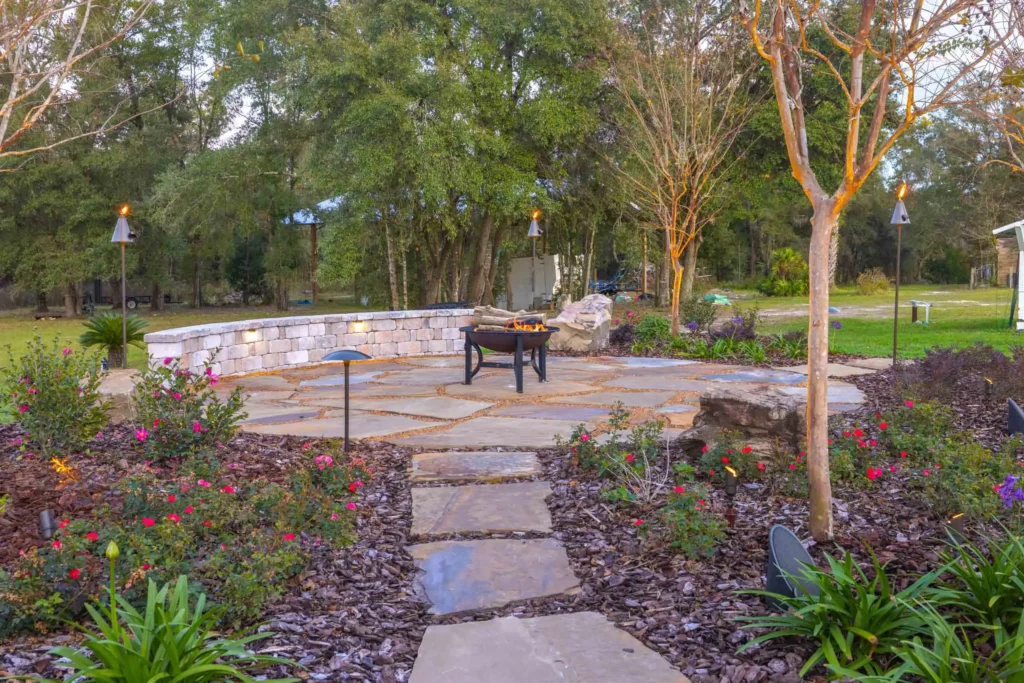
Rain can fall in buckets from June to September, yet Gainesville still faces watering restrictions during dry snaps. Xeriscaping—designing with water efficiency in mind—protects your garden and our vital Floridan aquifer. The goal isn’t cactus-only minimalism; it’s a thoughtful mix of lawn alternatives, smart irrigation, and soil stewardship that thrives on rainfall first and supplemental water only when truly needed.
Key Elements
-
Drought-tolerant groundcovers. Swap thirsty St. Augustine turf for Bahia grass, sunshine mimosa, or a perennial peanut “living mulch” that stays green on half the water and fixes nitrogen into your soil. These species shrug off Gainesville’s summer heat and rebound quickly after mild frosts.
-
Soil amendment & mulching. Before planting, blend in 3 inches of compost or aged pine bark fines; organic matter acts like a sponge, holding moisture near roots. Top-dress beds with a 2-3 in. layer of pine straw or shredded oak leaves to cut evaporation by up to 30 percent and suppress weeds.
-
Drip irrigation lines. Low-pressure poly tubing buried under mulch delivers moisture straight to root zones, reducing evaporation by up to 70 percent. Pair the system with a Wi-Fi controller that skips cycles after a Gainesville thunderstorm.
-
Rain-garden basins. Direct gutter downspouts to shallow bowls planted with canna lilies, sweetspire, switchgrass, and blue flag iris. During a cloudburst, the basin holds runoff, filters nutrients, and lets water percolate back into the soil—recharging groundwater instead of overwhelming storm drains.
-
Micro-zoning. Cluster plants with similar moisture needs—palmettos and yucca on higher, drier berms; moisture-lovers such as Louisiana iris in low spots. This “hydrozoning” ensures every drop lands where it counts.
Pro Move: Tuck a pair of 55-gallon rain barrels beside the house—one near the vegetable beds, another by the patio. A single summer storm can fill them, giving you 110 gallons of free irrigation for containers during drought weeks. Add a mosquito-proof screen and an overflow hose that feeds your rain garden.
Big Picture: Combined, these tactics create a self-balancing mini-ecosystem that needs less oversight, lowers your water bill, and sails through Gainesville’s wild weather mood swings while keeping landscapes lush—not crispy.
3. Design an Outdoor Living Room That Beats the Heat

Why limit family time to four interior walls? With mild winters and SEC football Saturdays, outdoor rooms in Alachua County rival indoor dens for daily use.
Build Your Space in Layers
-
Floor: A shellstone or antique-brick paver patio pairs Gainesville’s Southern charm with coastal flair. Lay pavers on a compacted limerock base; choose light hues that reflect heat and make a small yard feel larger. Consider a contrasting paver border that frames the space like a rug.
-
Cover: A cedar pergola softened by Confederate jasmine vines offers dappled shade plus citrus-sweet scent each spring. For all-weather protection, add a retractable awning or twinwall polycarbonate panels over half the structure, creating sun and rain zones.
-
Cooling assets: Install damp-rated ceiling fans beneath the rafters and run a discreet mist line along one beam—combined, they can drop perceived temperature by 10 °F. For winter, mount an infrared heater bar to extend patio season without bulky propane towers.
-
Furnishings: Invest in Sunbrella-covered sectionals, teak dining sets, or HDPE “plastic lumber” Adirondacks that shrug off afternoon showers. Add washable polypropylene rugs for an indoor feel and quick-dry accent pillows in Gator orange or sunrise coral.
-
Functional extras: Integrate low-voltage LED sconces on pergola posts, install an outdoor-rated fridge inside a masonry island, and run conduit for future speaker or Ethernet lines—you’ll thank yourself later.
Game-Day Bonus: Mount a weather-sealed television under the pergola, connect to Wi-Fi, and cue the fight song. Suddenly you’ve created the ultimate Gators watch zone—no sticky stadium seats required.
Finishing Touch: Ring the patio with glazed ceramic containers overflowing with chartreuse coleus, electric-pink caladiums, and trailing sweet potato vine. The result? A space so welcoming you may cancel those indoor renovation plans.
4. Boost Curb Appeal with a Gainesville‑Styled Front Walk
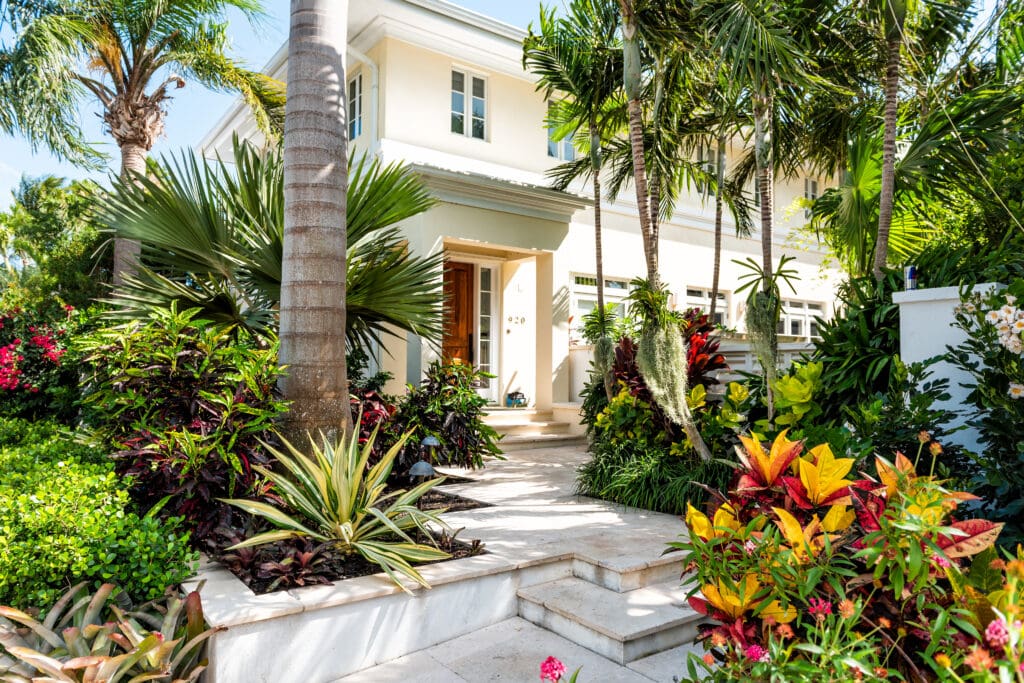
First impressions matter—especially along tree-canopied streets where every porch tells a story. A welcoming walkway draws the eye from curb to doorway while hinting at your home’s personality and boosting appraised value.
Steps to Success
-
Curved route. Soft arcs feel more gracious than a straight shot and create pockets for planting. Keep curves gentle—minimum 4-ft radius—to avoid mower headaches.
-
Historic materials. Antique brick, coquina-shell pavers, or locally quarried limerock echo Gainesville’s 19th-century charm and handle humidity without warping. Consider inlaying a darker soldier course (edge row) for definition.
-
Layered greenery. Use dwarf yaupon holly or podocarpus for evergreen structure; underplant with azaleas for spring fireworks, and finish borders with pentas, sunshine mimosa, or dwarf lantana for year-round edging color and pollinator traffic.
-
Textural accents. Sneak in a trio of copper landscape art pieces or a vintage cast-iron urn at path bends for a “slow-reveal” effect that entices visitors forward.
-
Accessible grading. Slope the path no more than 5 percent and break long runs with 4-in. risers if needed—grandparents and kids alike will appreciate the comfortable stroll.
Nighttime Wow: Accent focal points—an architectural column, prized live oak, or heritage porch swing—with bronze uplights on 24-° beams. Low-voltage fixtures every 8–10 ft bathe the walkway in a warm 2700 K glow, ensuring safe footing and a welcoming ambiance long after sunset.
5. Create a Private Backyard Oasis
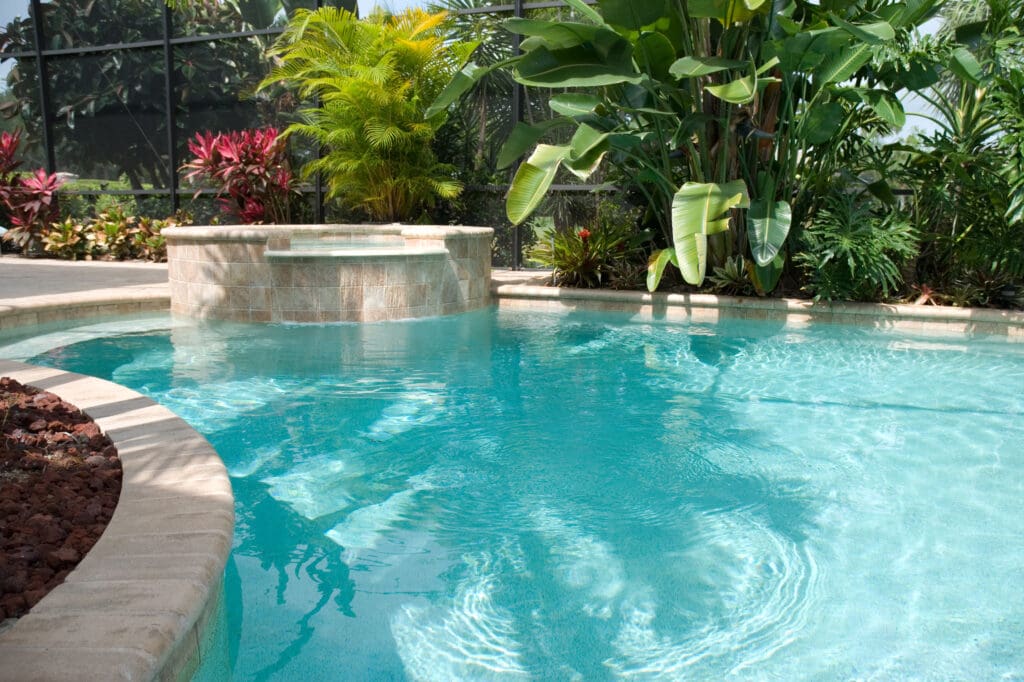
A tranquil retreat is possible—even on a tight urban lot. The trick lies in layering living screens instead of building fortress‑style fences.
Privacy Palette
-
Clumping bamboo (non-invasive) shoots to 12–15 ft in two seasons when mulched and drip-irrigated. ‘Graceful’ or ‘Alphonse Karr’ varieties bend elegantly in the wind.
-
Simpson’s stopper forms a dense, glossy hedge sprinkled with white blossoms and red berries that attract pollinators and cardinals. Prune lightly to maintain shape or let it grow informally to 15 ft.
-
Southern wax myrtle handles wet feet, dry spells, and salt spray—ideal for low spots. Its fragrant foliage deters mosquitoes when crushed.
-
Confederate jasmine races up lattice panels or hog-wire trellises to hide AC units and sheds, releasing perfume each May.
Sensory Upgrades
-
Sound buffer: A bubbling urn, basalt column fountain, or narrow recirculating stream masks neighborhood noise with white sound. Low-flow pumps cost pennies a day.
-
Ground plane: Flagstone steppers drift through beds of native river fern, cast-iron plant, and blue ginger for a lush, sub-tropical woodland vibe.
-
Night & fire: Solar Edison-bulb string lights drape overhead, while a copper fire bowl on a crushed-shell pad invites marshmallow roasting from October through February.
Result: an urban hideaway that feels like Paynes Prairie meets spa garden—without HOA complaint letters.
Need help designing privacy that feels like paradise? Request a free backyard consultation with our Gainesville landscape team today!
6. Invite Butterflies & Birds with a Pollinator Paradise
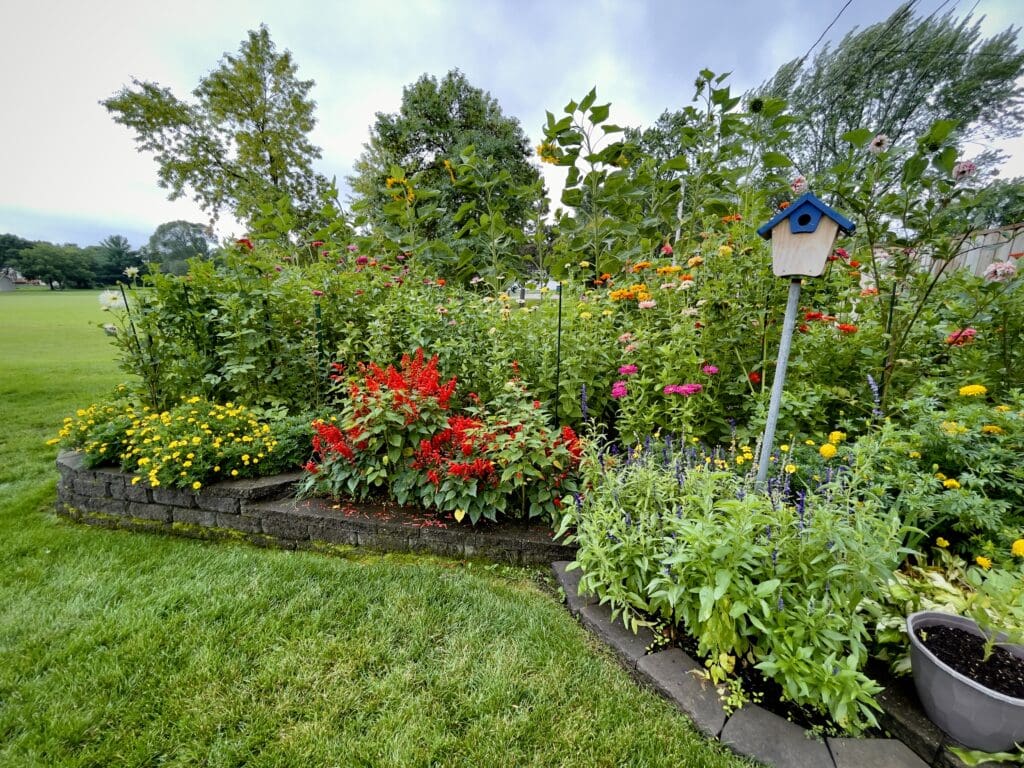
Few sights delight like monarchs drifting through a flower bed. Pollinator gardens also support Gainesville’s ecosystem and increase fruit set in nearby edibles.
Build a Pollinator Patch
-
Host plants: Milkweed species—Asclepias tuberosa, A. incarnata, and native A. humistrata—give monarch caterpillars a buffet. Plant in the sun, cut back in winter to reduce OE disease.
-
Nectar sources: Layer color calendars so something blooms every month: scarlet sage in March, blanket flower and pentas May–August, blue porterweed into October; goldenrod and tropical sage close the year.
-
Structure & shelter: Butterflies need open sun to warm their wings and evergreen shrubs or ornamental grasses to hide from summer storms and lizards. A 3-ft-tall drift of muhly grass doubles as fall fireworks.
-
Water dishes: Fill shallow terra-cotta saucers with pea gravel so insects sip without drowning. Add a pinch of sea salt for minerals.
-
Organic practices: Skip systemic pesticides; use neem or insecticidal soap only at dusk when pollinators have bedded down.
Design Tip: Group each species in clumps of five or more; pollinators are short-sighted, and big color blocks are easier to spot than peppered singles. Edge the bed with recycled-cedar planks or mini-gabion cages to keep mulch contained and add visual flair.
7. Plan for Year‑Round Color and Easy Upkeep
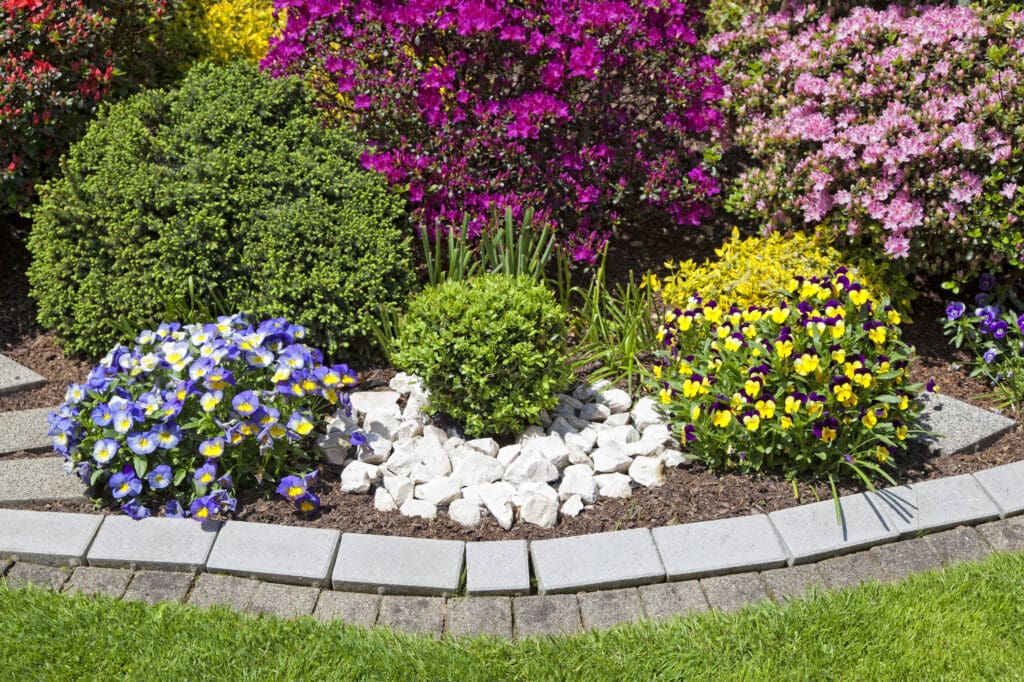
Unlike northern yards that nap under snow, Gainesville landscapes can celebrate color in every month—if you stagger bloom and foliage cycles.
Four-Season Planting Strategy
-
Winter (Dec-Feb): Camellias ‘Debutante’ or ‘Winter’s Snowman’, ornamental cabbage/kale, and fire-red nandina berries pop against dormant turf.
-
Spring (Mar-Apr): Azaleas, Eastern redbud, native blue phlox, and a fresh top-dress of ryegrass overseed wake up the yard just in time for graduation parties.
-
Summer (May-Aug): Heat-hardened hibiscus, pentas, crape myrtle (‘Natchez’ for white, ‘Dynamite’ for red), and orange canna lilies handle Gainesville’s humidity with flair.
-
Fall (Sep-Nov): Firebush, goldenrod, and purple fountain grass glow while maples start to bronze; add crotons in containers for instant tropical fireworks.
Layering Tricks
-
Focal evergreens: Podocarpus columns or dwarf magnolias anchor beds through all seasons.
-
Mass planting: Sweep large drifts of a single species—20 pentas, not two—in broad curves. Fewer edge lines mean quicker mowing and a polished designer aesthetic.
-
Perennial back-ups: Plant daylilies or society garlic behind annual color blocks; when annuals fade, the perennials keep greenery alive.
Maintenance Hack: Replenish pine bark nuggets or pine straw each February; mulch moderates soil temperature, suppresses weeds, and feeds microbes as it breaks down. With strategic layering, your Gainesville garden will glow 365 days a year and still clock fewer maintenance hours than a traditional lawn.
8. Light Up Gainesville Evenings with Layered Outdoor Lighting
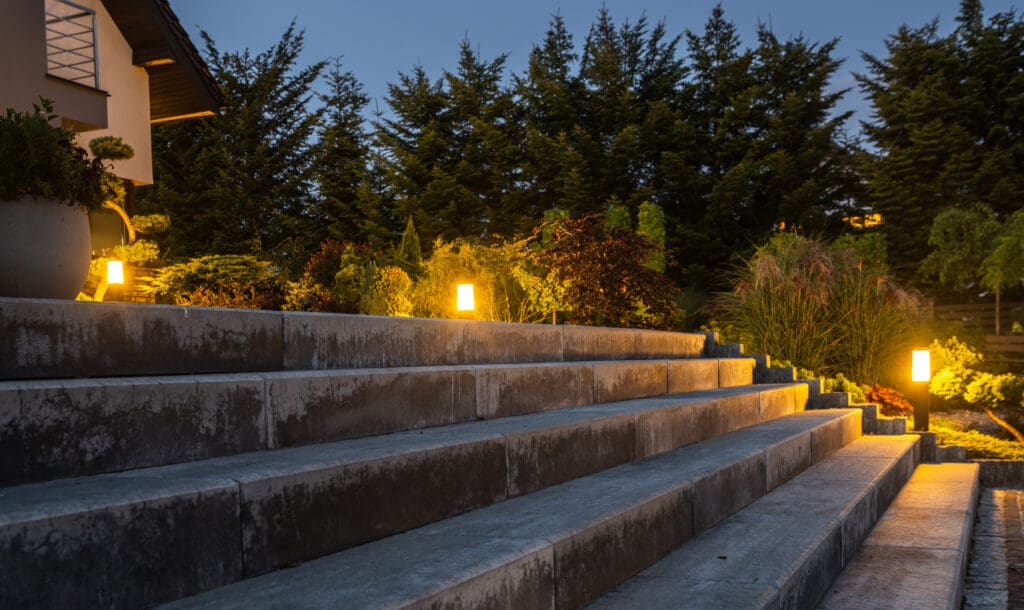
One switch can turn a good landscape into a jaw-dropping nighttime scene. Layered lighting improves safety, extends entertaining hours, and reveals bark textures and palm fronds you never noticed in daylight.
Must-Have Fixtures & Tips
-
Path lights placed 18 in. off-center along walkways and driveway edges guide guests safely without runway glare.
-
Downlights mounted in live oaks (the “moonlight” technique) cast dappled shadows on groundcover—stunning and subtle.
-
Uplights at the base of sabal palms or heritage oaks dramatize trunks and twisting limbs; opt for 15-watt LEDs with 36-° beams for a gentle wash.
-
String or bistro lights zigzagged overhead create café ambience on patios; use shatter-proof bulbs rated to 120 °F.
-
Submersible LEDs in fountains or bubbling urns make water sparkle after dusk. Choose RGB fixtures if you want Gator-orange for game nights.
Smart Controls
Pair all fixtures with a low-voltage transformer connected to a Wi-Fi timer or photocell. Automations adjust for Gainesville’s shifting sunset times and let you dim zones from your phone, saving energy while giving instant mood control.
Pro hint: Warm-white (2700–3000 K) LEDs flatter skin tones and plant foliage; reserve cool-white for modern sculptures or blue-glass water features.
9. Water-Wise Irrigation
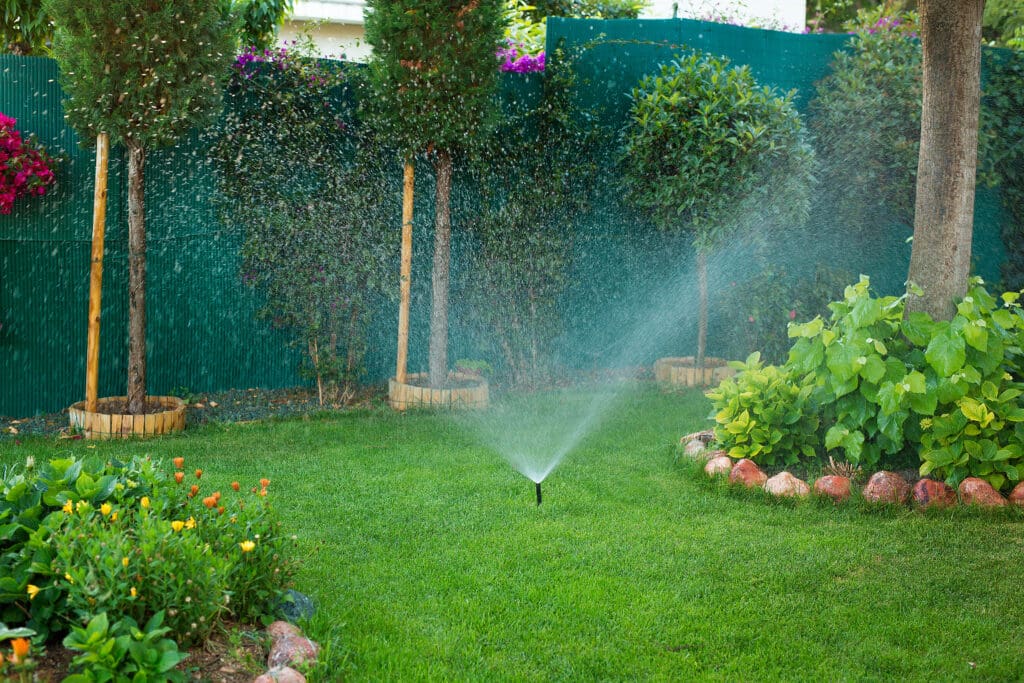
In Florida, conserving water is just as important as creating a beautiful landscape. Gainesville homeowners can slash waste yet keep gardens vibrant by rethinking how water is delivered.
Water-Saving Design Principles
-
Hydrozoning: Cluster plants by thirst level—succulents on sunny slopes, azaleas in filtered shade—then set each zone on its own valve.
-
Drip over spray: Emitters deliver water directly to roots, cutting evaporation up to 70 percent and minimizing fungal leaf spots common in humid summers.
-
Soil moisture meters: Smart sensors buried 4–6 in. below grade pause irrigation when soil holds adequate moisture—no more sprinklers running in the rain.
-
Berm & swale contouring: Gentle ridges capture downpour sheet-flow, letting beds sip slowly instead of sending nutrients to the storm drain.
Smart Upgrades for Gainesville Yards
-
Rain-sensing controllers automatically skip cycles after a thunderstorm. Models like Rachio can integrate with NOAA forecasts for predictive watering.
-
Flow meters detect leaks—if a line bursts, the valve shuts off and sends an alert, saving water and landscape.
-
Rain-barrel networks: Daisy-chain multiple barrels to a small booster pump and hose bib—free irrigation for the herb garden all summer.
Drought-Tough Turf & Alternatives
Trade St. Augustine for Bahia grass, perennial peanut, or sunshine mimosa, which need one-third the water and virtually no nitrogen fertilizer. Better yet, swap more lawn for ornamental beds or a relaxing gravel courtyard shaded by live oaks.
Bottom Line: Water-wise landscapes save time, money, and Gainesville’s natural springs—proof that stewardship and style can coexist beautifully.
10. Shape Your Yard with Artful Hardscapes
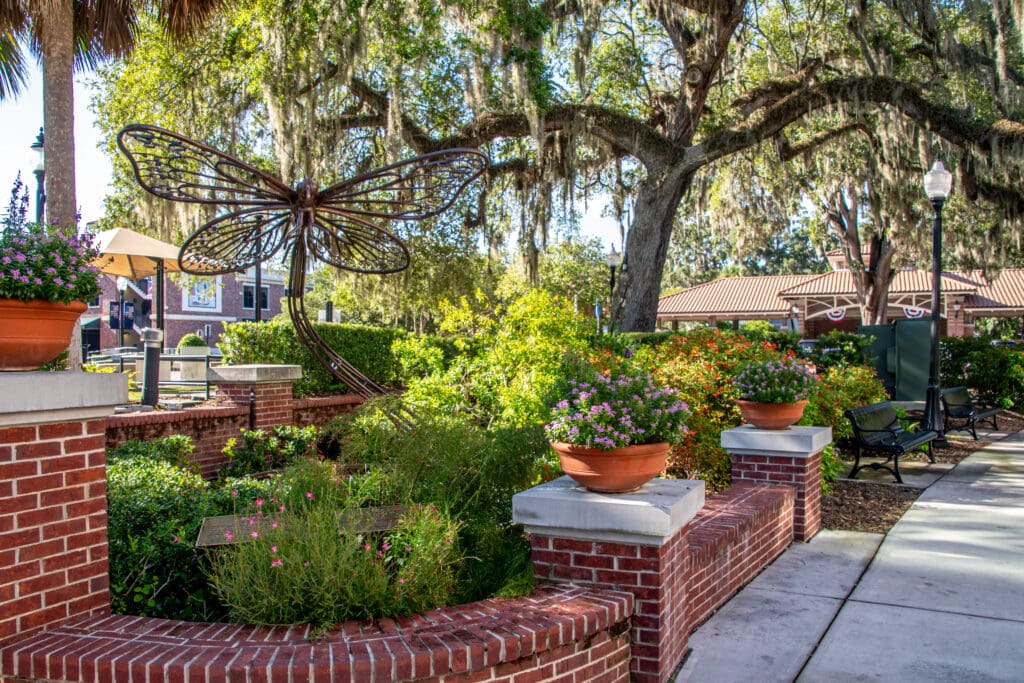
Plants may steal the show, but hardscaping—patios, walls, walkways, and art—gives structure when blooms fade and provides four-season interest.
Popular Hardscape Ideas & Best Practices
-
Dry creek bed: A curving river-rock swale channels roof runoff, prevents erosion, and doubles as a focal line of sight. Line the trench with geotextile fabric, then top with mixed river pebbles and accent boulders; tuck in dwarf liriope on banks for a natural edge.
-
Fire-pit terrace: A sunken circle paved in buff limestone or reclaimed Chicago brick, ringed by seating walls capped in coquina stone, invites stargazing from October’s Orion show to March’s Venus evenings. Ensure a 10-ft buffer from structures.
-
Retaining or seat walls: Low stacked-block walls (24-in.) define lawn edge, offer bonus seating, and tame gentle slopes common in western Alachua County.
-
Sculptural accents: Weathered driftwood, corten-steel trellises, or a mosaic stepping-stone path add personality without overcrowding beds. Position large pieces on the golden ratio’s 60/40 line for visual balance.
Pro Construction Tips
-
Drainage first. Grade patios at a ⅛-in. per-foot slope away from your house; embed a 4-in. perforated drainpipe behind walls to survive Gainesville’s summer downpours.
-
Material continuity. Repeat one dominant hardscape material—say, brick—in at least three spots (patio border, fire pit band, front walkway soldier course) to knit the landscape together.
-
Lighting integration. Pre-wire seat walls and stair treads with 12-volt LED strip lights before capping; retrofits cost 3× more later.
With the bones in place, swapping out seasonal color feels like dressing a well-built home—effortless and always stylish.
Bonus Tip: Serve Florida Flavor with Edible Landscaping
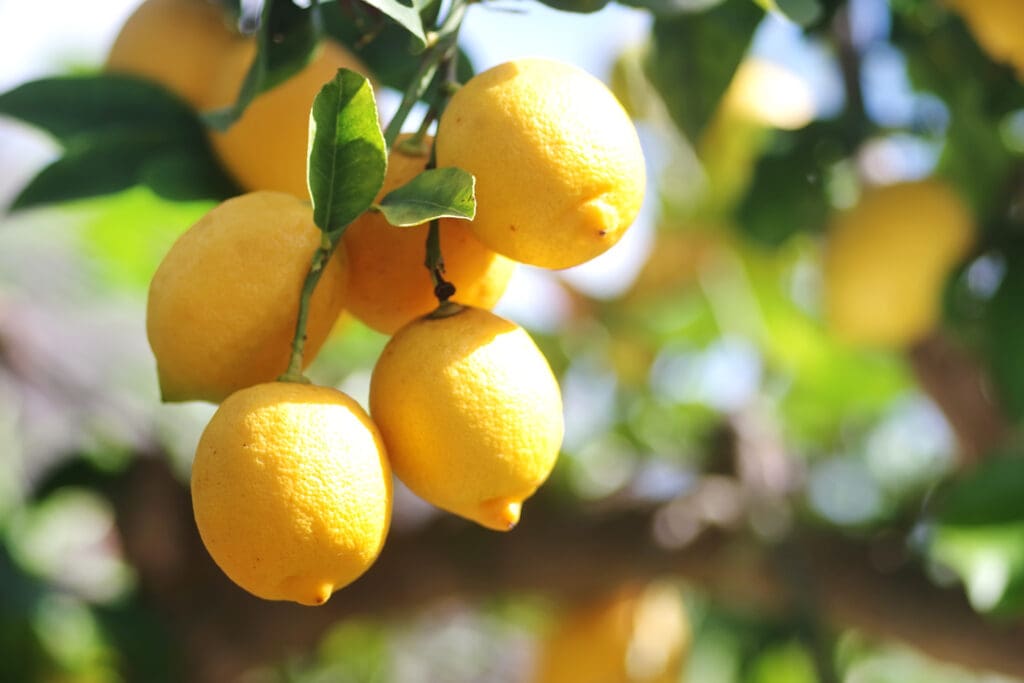
Blend beauty and bounty by folding herbs, fruits, and vegetables into ornamental beds—a method known as foodscaping. It maximizes limited space, turns daily yard strolls into snack runs, and showcases Gainesville’s long growing season.
Instead of hiding edibles in a separate plot, weave them among flowers and shrubs so every corner looks lush and productive.
Top Gainesville Edibles
| Crop | Why It Shines in Gainesville | Landscape Role | Care Notes |
|---|---|---|---|
| Meyer lemon & Loquat trees | Both handle our zone-9a winters (down to ≈ 26 °F) and fill the air with citrus perfume each March. | Small accent trees; place near patios for scent. | Plant on a slightly raised mound; apply citrus-specific fertilizer in Feb/May/Aug. |
| Southern Highbush blueberries (e.g., ‘Emerald’, ‘Jewel’) | Thrive in Gainesville’s naturally acidic, sandy loam. | Deciduous hedge 4-6 ft tall that blazes red in fall. | Plant two cultivars for cross-pollination & bigger yields. Mulch with pine bark to mimic forest floor. |
| Rosemary, thyme, oregano | Mediterranean herbs that laugh at drought once established. | Evergreen mounds edging walkways; release fragrance when brushed. | Shear lightly after bloom; avoid water-logged spots. |
| Leafy greens (Swiss chard, Tuscan kale) | Grow October – April when temps are mild. | Bold chartreuse or ruby foliage pops against ornamental grasses. | Pick outer leaves weekly to keep plants youthful. |
| Hot peppers & eggplant | Love Gainesville’s summer heat and humidity. | Colorful “living ornaments” in pots or front beds. | Stake early; harvest regularly to encourage new fruit. |
Pro Pairing: Alternate purple basil with orange marigolds for an eye-catching University of Florida color scheme and a built-in pest-repellent combo—basil masks tomato hornworm pheromones, while marigolds deter nematodes.
Design & Maintenance Tips
-
Raised cedar bed near the kitchen: A 4 × 8 ft box filled with compost-rich soil keeps salad greens, baby carrots, and dwarf cherry tomatoes within arm’s reach of the stove.
-
Succession planting: Stagger sowings every three weeks so you harvest butter lettuce long before 90 °F days arrive; follow with heat-loving okra in the same spot.
-
Irrigation: Run a ½-in. drip mainline along each bed edge, then ¼-in. emitters to individual plants. Automatic timers water at dawn, keeping foliage dry and crispy even in August’s steamy afternoons.
-
Ornamental structure: Tuck a powder-coated obelisk into the center of the bed—Malabar spinach or pole beans climb up while adding a vertical accent.
-
Wildlife management: Net blueberries once they blush; leave a few fruiting figs unprotected—mockingbirds make quick work of caterpillars in exchange for figs.
Foodscaping turns chores into exploration, shortens your grocery list, and sparks conversation when guests realize the hedge is edible!
Frequently Asked Questions (FAQ)
Q1: What is the best time to plant trees in Gainesville?
A: Early fall (late September through November) is ideal. Cooler air and warm soil let roots establish before summer heat returns, reducing transplant shock.
Q2: Do I need a permit to remove or plant large trees?
A: Gainesville and Alachua County have tree ordinances. Always check local regulations or consult a certified arborist before removing protected species.
Q3: How can I keep my lawn green without high water bills?
A: Switch to drought‑tolerant turf like Bahia or install a drip irrigation system with a rain sensor. Water before 10 a.m. to minimize evaporation.
Q4: Will native plants look wild and unkempt?
A: Not if arranged with intention. Use curved beds, distinct borders, and repeat groupings of each species for a polished, designer aesthetic.
Bring Your Gainesville Landscape Vision to Life
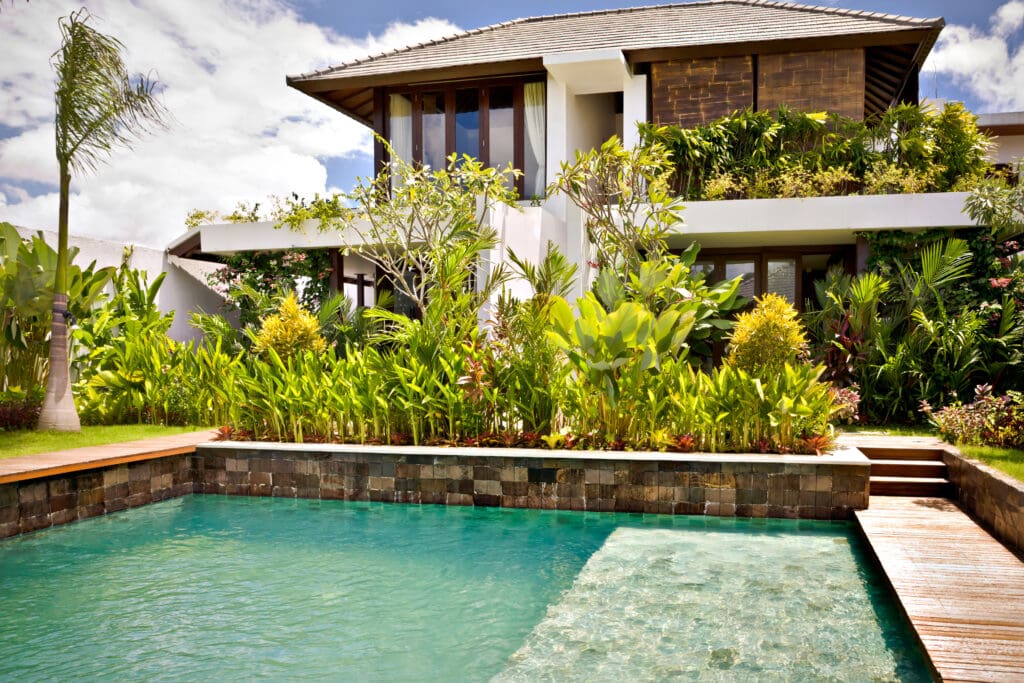
By weaving together native plantings, smart water strategies, outdoor living zones, and vibrant hardscapes, you’ll craft a yard that thrives in Gainesville’s unique climate—and mirrors your personal style. Your outdoor spaces will lower maintenance, increase property value, and become cherished backdrops for family memories.
Ready to Transform Your Yard?
Contact our award‑winning Gainesville landscaping team today for a complimentary design consultation. We’ll listen to your goals, craft a tailored plan, and handle every detail—from concept to installation—so you can sit back and watch your sustainable Florida oasis come to life.